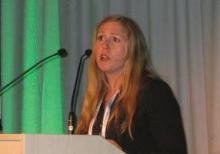MUNICH – Hormones and drugs used for fertility treatment of women caused no overall excess of cancers in either the treated women or their children during relatively long follow-up in two large, separate epidemiologic studies.
But results from each of the two studies also showed some evidence of an increased incidence of a few specific types of cancers from two ovarian-stimulating agents, suggesting a need for caution and continued surveillance.
One study, which used a case-control design to analyze data from several Danish national registries, showed that children born to women treated with progesterone had a significantly elevated incidence of leukemias in general, of acute lymphoblastic leukemia specifically, and also of sympathetic nervous system tumors such as neuroblastomas, Marie Hargreave, Ph.D., said at the annual meeting of the European Society of Human Reproduction and Embryology.
"Taking into account the biological plausibility that fertility drugs could cause cancer in children, these results are strong enough to cause concern," said Dr. Hargreave, a researcher at the Danish Cancer Society Research Center.
The second report, a retrospective analysis of cancer cases among nearly 10,000 women who underwent ovulation stimulation at any of five U.S. fertility centers and were followed for 30 years, showed that two very specific subgroups of woman had a significantly increased number of cancers associated with treatment by the ovulation-stimulating drug clomiphene citrate, a selective estrogen-receptor modulator. Nulligravid women treated with clomiphene who then remained nulligravid through follow-up had a significantly increased rate of ovarian cancer, but not breast or endometrial cancer, reported Dr. Humberto Scoccia, professor of ob.gyn. and medical director of the in vitro fertilization program at the University of Illinois in Chicago.
In addition, the small group of 31 women who developed invasive breast cancer during follow-up showed a statistically significant increased rate of this cancer among the women who received clomiphene for 12 or more ovulatory cycles.
However, women in the study received treatment during 1965-1988, an era when clomiphene was used more often and at higher dosages than is typical today, when the maximum number of clomiphene-treatment cycles usually tops out at six, Dr. Scoccia said.
The Danish study used data collected from several national registries on nearly 91,000 children born to mothers who had fertility treatment during 1964-2006. The study focused on 148 of these children who developed cancer as children or young adults, and compared the treatments that their mothers had received with 1,289 cancer-free children born to mothers who had fertility treatment.
The overall findings showed no significantly increased risk for any type of cancer linked with any drug or hormone exposure the mothers received – "quite reassuring results," Dr. Hargreave said.
However, a more granular analysis revealed a few cancers linked to maternal progesterone treatment. Children born to mothers who received progesterone during three or more ovulatory cycles had a statistically significant, fourfold increased rate of all types of leukemias. Cases of acute lymphoblastic leukemia specifically occurred at a significantly increased rate in children whose mothers had received any progesterone exposure, and among children whose mothers received the hormone during three or more cycles, the rate was nearly 10-fold higher than the rate seen in children whose mothers had no progesterone.
In addition, any maternal progesterone exposure also was linked to a significant, nearly sixfold increased rate of sympathetic nervous system tumors in the children. No other drug or hormones used – including clomiphene and various gonadotropins – showed any significant links to offspring cancers.
"This is the largest study reported to date with data on specific fertility drugs, as it had an appropriate reference group," children who remained cancer free but were born to mothers who underwent fertility treatment, Dr. Hargreave noted. She also cautioned that the subanalyses for specific cancer and treatment types involved relatively small numbers of cases.
"Some of the numbers in the subgroup analyses are so small that the findings need to be interpreted with caution," Dr. Scoccia commented during the session. "Multiple prior studies looked at progesterone and did not see a problem," he noted.
"More study of progesterone is needed, as this is the first large epidemiologic study to show this effect," Dr. Hargreave said. "What is important in this study is that we saw no overall increase in cancer rates."
The U.S. study reported by Dr. Scoccia reviewed 9,892 women treated at any of five U.S. fertility clinics during 1965-1988 who also completed a questionnaire in 2000, resulting in follow-up for a median of 30 years from when they received ovulation stimulation. During follow-up, 749 women developed breast cancer, 118 developed endometrial cancer, and 85 developed ovarian cancer.



